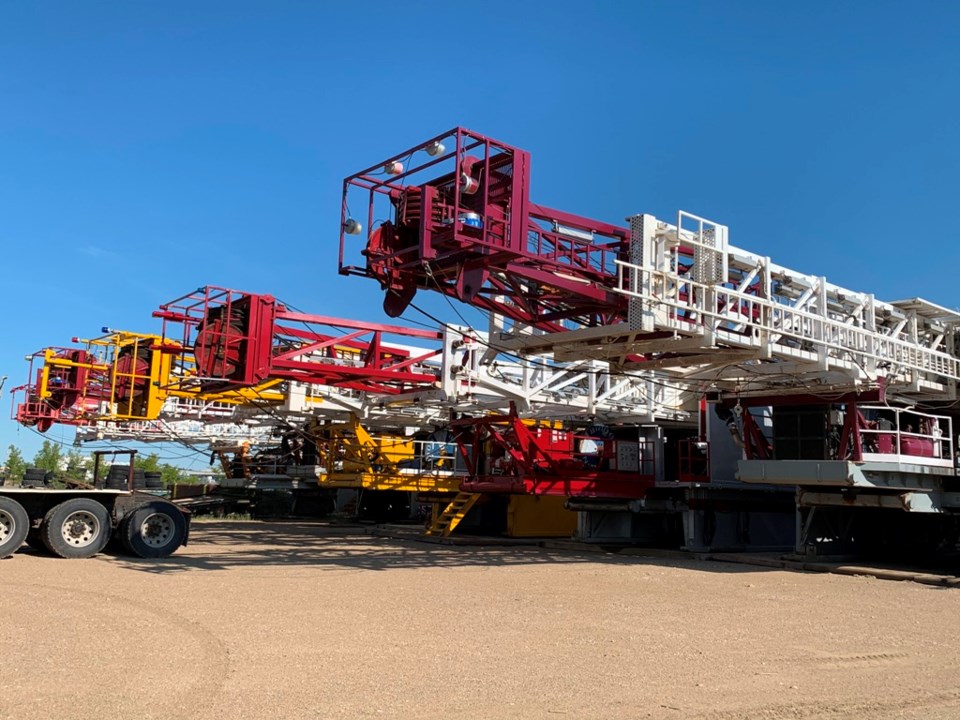In recent years, by mid-July there would be 30 to 50 drilling rigs working throughout Saskatchewan. Nearly all would be drilling for oil, but one or two would be drilling for potash or helium.
The active drilling rig count is one of the key leading indicators of the oil industry. As of July 16, there was just one rig working in Saskatchewan, and it was drilling for helium, according to Rig Locator (riglocator.ca). According the Rig Locator, no drilling rigs have been drilling for oil in Saskatchewan since the end of the winter drilling season in mid-March.
Additionally, Saskatchewan’s oil production went from 502,700 barrels per day in March, 2020, to 361,000 bpd in May, a decline of 28.2 per cent. When oil prices cratered in April, many oil producers shut-in (i.e. shut down) substantial portions of their production and all ceased drilling.
The tremendous destruction in demand for oil around the world came with the onset of the COVID-19 crisis which occurred in mid-March. This coincided with Saudi Arabia and Russia flooding the market with additional oil. In mid-April, West Texas Intermediate (WTI) oil briefly went into negative pricing territory for one day. Since then WTI has comb back to US$40 per barrel, but drilling has not resumed and rigs are parked throughout the province.
Asked about this on July 16, Minister of Energy and Resources Bronwyn Eyre said, “Remember, before COVID, we had a strong, a strong winter drilling season right we talked about it in the early days of 2020.
“It seems like an eternity ago, but 756 new wells were drilled, which was a strong Q1 for 2020 and for that winter drilling season.”
She pointed out that Saskatchewan had a higher “drilled but uncompleted” (DUC) well count than other provinces at that same time. This could lead to an advantage in the future, she said, as those wells could be brought online more quickly when market conditions improve. The drilling cost is usually around 60 per cent, Eyre said. As new wells, they will have higher initial production rates and better cash flow than existing wells.
“Most new wells qualify for one of our volumetric drilling incentives of a 2.5% maximum Crown royalty rate,” Eyre said.
“I spoke to many, many companies and operators over the course of those months; March, April, May and June and I continue to. Our royalty regime is something that, even through these very difficult age, operators regard, and companies regard, as a beacon of stability,” she said.
Eyre said capital investment in exploration is expected to drop 50 per cent this year, compared to 2019, when it was $3.98 billion. This year she expects it to be closer to $2 billion.
“It's going to take some time, of course, to get back to those pre COVID drilling numbers. Obviously, we hope the numbers are going to increase even now, going into the latter part of 2020 into the late summer and fall.
“That sharp decline, of course, has had a major impact on the services sector, which is why we've been so focused on getting those funds out for the Accelerated Site Closure Program.”
Later in the day the province announced that has approved its first parcel of work packages to be completed through the Accelerated Site Closure Program (ASCP).
A total of 22 packages will engage up to 50 service companies and spread out the work for abandonment activities across the Lloydminster, Kindersley, Swift Current and Estevan areas. The work includes around 300 well abandonments, 300 flowline abandonments, 75 facility decommissions and 700 other activities related to site reclamation, the press release said.
The value of this first tranche of work packages is $12 million and encompasses six different oil and gas companies. Saskatchewan has been allotted $400 million from the federal government for the program.
NDP reaction to no drilling
On July 16 NDP finance and economy critic Trent Wotherspoon said regarding the rig count, “The complete lack of drilling represents a real hardship for Saskatchewan, families and workers and local companies. It certainly hurts our local economy, speaks to the speaks to the hardship that many are facing, and the importance of the energy sector as well to was Saskatchewan.
“And it certainly should serve as an important wake up call to the government to do all it can to build economic recovery and diverse job opportunities, of course, working with the traditional energy sector, but also just doing the simple things that create opportunity like putting Saskatchewan workers and businesses first when we procure and build projects with public money, making sure that those dollars aren't flowing far outside Saskatchewan to companies and workers,” Wotherspoon said.
“These are folks that are out of work, and we need to do all we can in other sectors as well to secure an economic recovery and provide opportunities,” he said.
Asked if there’s anything else the province can do, Wotherspoon said, “I think it's critical that you're engaged with the energy sector and having frank conversations about what they're facing, listening for those opportunities to make sure that that industry is on a solid footing and that it's in a position to build some employment and make some investments. Just working together, and listening to needs.”
As for well abandonment, he said, “We're kind of observing how it's rolling out it was a bit slow being rolled out in Saskatchewan. I think the question is going to be, how can the province maximize the returns for Saskatchewan people. I think it's very important that that work not be outsourced, the way that we've seen the Sask Party do time and time again.”
��
��




